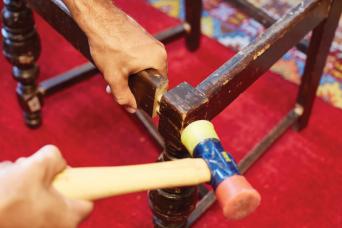
Making Appliances Easier to Repair Can Benefit Businesses and the Earth

Everyone, it seems, has an appliance story. Usually a small part is unavailable, requiring the household to junk the whole contraption.
Here’s mine: customer service, circa 2001:
Me: “I’d like to order new knobs for our cooktop.”
Rep: “I’m sorry but we don’t carry such old parts.”
Me: “Our cooktop is only 15 years old! What are you talking about?”
Rep: “Oh my, you’re so lucky your stove lasted you so long! The industry standard is only 5-7 years.”
And there you have it — planned obsolescence, brought to you by the manufacturing industry. Now, with luck, you can find a replacement part on eBay or through websites that specialize in replacement parts. However, many appliances large and small still wind up in landfills due to the absence of a small part. They’ll be keeping our cooktop company.
As Sandra Goldmark reports in her recent book “Fixation: How to Have Stuff without Breaking the Planet”, the absence of policies requiring manufacturers to design products so they can be repaired is a huge gift to manufacturers. When companies create products that cannot be dismantled (hello, iPhone) and therefore must be replaced, it’s a big boon for their bottom line. The absence of regulations guaranteeing replacement part availability further pads companies’ pockets.
Planned obsolescence is a fancy term for waste. Unavailable or inaccessible broken parts are only part of the story. Sometimes an appliance is not worth repairing; it makes no economic sense if the labor for repair exceeds the value of the item and it’s cheaper to replace it.
Goldmark points out that cheap products produced by low-wage companies are almost always more expensive to repair than replace. One of her recommendations is to generally buy less, but make sure it’s high quality.
Not only do customers pick up the bill for all these trashed items, so does our planet. All the resources embedded in the now-junked apparatus are wasted, and new resources (water, energy, raw materials, shipping materials, fuel for freight and delivery, etc.) are consumed to replace it.
During COVID, when many of us are nervous about inviting repair crews into our homes, YouTube has become a go-to problem solver. Lots of repairs people would never have imagined undertaking have turned out to be achievable, given available replacement parts and video instruction. By capitalizing on this in the future, manufacturers who want to legitimately claim they are environmentally responsible can make it easier for people to repair instead of replace.
Many of the videos are posted by average Joes showing off their DIY chops. These folks have experienced all the same crappy appliance breakdowns as the rest of us and are happy to share their repair victories with all who are interested.
Laws, regulations, and standards for manufactured products stipulating ease of repair would have a beneficial ecological impact. Possible reforms include:
- Products must be designed to be dismantled into component parts, easing repair as well as recycling of the discarded parts
- Companies must offer replacement parts for 15 years (or more?)
- Manufacturers must provide a video showing basic repairs
- As 3-D printing accessibility expands, manufacturers must provide plans for producing their replacement parts
If this wish list is unattainable, the system could be voluntary, with manufacturers eligible to earn a Green Repair seal. Consumers concerned about quality and fixability could seek out products with this certification.
Goldmark’s background as a set designer led her to organize and offer repair cafes in New York City. A few years ago, there were similar initiatives in Northwest Philly; let’s revive them post-COVID. Encouraging the option to fix rather than repair will provide income for fixers, save consumers some money, and decrease the flow of dead appliances in our kitchen-counter-to-landfill pipeline.
Betsy Teutsch is the author of a recent book, “100 Under $100: Tools for Reducing Postharvest Losses.”
